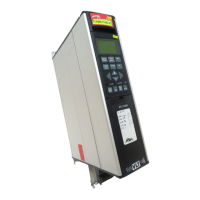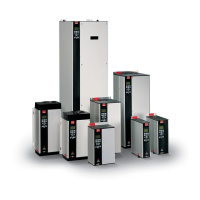135
MG.10.J4.02 – VLT is a registered Danfoss trade mark
VLT
®
5000 SyncPos option
10 ACCMAXQC
ACCMAXQC determines the maximum accelera-
tion. This is the amount of time the drive needs
with a connected load to achieve the maximum
rotation. All other statements made with the
assistance of the scaling VELRES (22) refer to this
acceleration.
This internal parameter – which cannot be chan-
ged – is automatically calculated from RAMPMIN
(31), which the user enters in ms. These internal
values are decisive for the value range permitted.
However, in practice these limit values are of no
importance.
Content
Maximum acceleration
Parameter Group
AXV
Unit
qc/(ms)
2
* 1/65536
Value range
1 … MLONG
NB!
If a starting time is entered which is too
short, which under the existing mechanical
conditions causes non-achievable acceleration,
usually a position error will occur.
11 KPROP (702)
The
Proportional factor Proportional factor
Proportional factor Proportional factor
Proportional factor KPROP indicates the
linear correction factor with which the deviation
between the current set and actual position is
evaluated and a corresponding correction of the
motor torque is made.
Rule of Thumb:
KPROP greater = Drive will become ‘stiffer’
KPROP too high = Tendency to overswing
Content
Proportional value for PID control
Parameter Group
AXR
Value range
1 … 65000 ★ 30
12 KDER (703)
The
Derivative factorDerivative factor
Derivative factorDerivative factor
Derivative factor KDER is the correction factor
with which the changing speed of a motor position
error is evaluated.
The derivative factor works against the tendency to
overswing due to a high proportional share and
'dampens' the system. However, if the derivative
factor selected is too large this will lead to a
'nervous' drive.
Content
Derivative value for PID control
Parameter Group
AXR
Value range
0 … 65000 ★ 0
13 KINT (704)
The
Integral FactorIntegral Factor
Integral FactorIntegral Factor
Integral Factor KINT is the weighting factor,
with which at time n the sum of all motor position
errors are evaluated.
The integral factor of the PID filter causes a cor-
responding corrective motor torque which increa-
ses over time. Through the integral share a static
position error is reduced to zero, even if a constant
load is affecting the motor.
However, an integral factor which is too large leads
to a 'nervous' drive.
Content
Integral value for PID control
Parameter Group
AXR
Value range
0 … 65000 ★ 0
Parameter Reference

